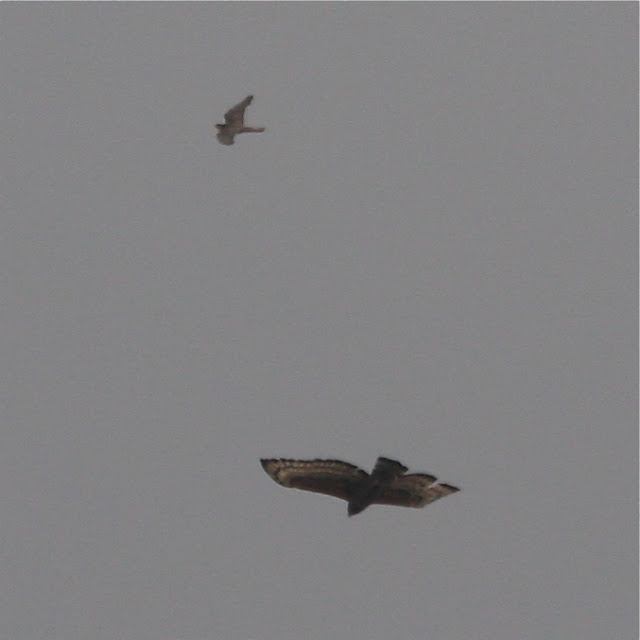Wednesday 31 October 2012
Vincent's Bunting: first pictures on the internet?
I photographed this skulking Vincent's Bunting at about 1700m on Mount Mulanje, Malawi, earlier this month. The location was between Chambe and Likhubula and the bird was foraging in miombo type vegetation scorched by fire (presumably deliberately set by poachers).
At the time of the sighting I realised that the bird appeared darker toned than the Cape Buntings that I had seen in South Africa a few years ago, but thought little more of it. Only once I was down the mountain did I refer to Sinclair and Ryan's Birds of Africa south of the Sahara that I had picked up in Nairobi Airport and notice the Vincent's Bunting illustration. In the photo above the lack of rufous on the coverts seems to be quite different from typical Emberiza capensis. Vincent's Bunting had not been on my radar as the excellent Birds of Malawi by Dowsett-Lemaire and Dowsett lumps these two species together as Cape Bunting.
I have now read that most authorities split the Vincent's Bunting as a separate more northerly mountain-dwelling species. Unusually for the internet there appear to be no searchable photographs of Vincent's Bunting available and I have even drawn a blank when searching for this form labelled as Cape Bunting. So, it is possible that these shot are an internet first!...
From the limited information that is available it seems that Emberiza vincenti is an uncommon endemic living in granite outcrops in a restricted part of Zambia, Malawi and Mozambique. Presumably, given its subtle plumage and (possibly) shy nature (this individual flew once it was aware that it was under observation), along with its restricted range and former subspecies status, the Vincent's Bunting has not been a high-profile target in Malawi for most camera-toting visiting ornithologists.
Tuesday 30 October 2012
Yellowbill, Liwonde, Malawi
Frank, one of the guides at Liwonde National Park was determined to find a Pel's Fishing Owl during my 20 hours in Liwonde last week. Well, the owl had not read the script but I was not complaining when Frank spotted this Yellowbill (Green Malkoha) in the depths of a sausage tree. Difficult to see and difficult to photograph I was delighted with the prolonged views of this individual as it foraged slowly under the canopy. I think the owl is seen at Liwonde about 20 times more frequently than the Yellowbill... ...so I'm happy to leave that until a future visit!
Monday 29 October 2012
Lanner Falcon mobbing Crowned Hawk-eagle
There is nothing like the excitement of an aerial tussle between raptors. This spat occurred after this Crowned Hawk-Eagle lifted through airspace that appeared to belong to a pair of Lanner Falcons. The feisty falcons looked to have the upperhand but the Hawk-eagle continued to rise and then thermalled away with a Steppe Buzzard. Only moments earlier a Verreaux's Eagle
had cruised over. This bumper crop was atypical of my recent trip to
Malawi. Although I managed to notch up 25 species of raptors over the
fortnight, most sightings were of individual birds, and for 15 of those species, a single sighting was all that I managed.
Sunday 28 October 2012
Crowned Hawk-Eagle, Mount Mulanje, Malawi
I have returned recently from a trip to Malawi. A work trip rather than a birding trip, but there was a fair opportunity to use the long lens from time to time. Wildlife appeared to be thin on the ground given the subsistence nature of most of Malawi's human population. Tree cutting, fire-assisted poaching and snare poaching appeared to be widespread even in protected areas. While I sympathise with the plight of those who are in need, at the current rate of habitat destruction I think Malawi will likely lose its status as a serious birding destination in the very near future. More on that in a future post...
For the time being here was one of the birding highlights for me in Malawi. After 3 days of trekking through the ashes of what was nominally Mount Mulanje Forest Reserve, I spotted this Crowned Hawk-Eagle roosting in the canopy along an unburnt ridge. It then took to the air and powered up into the sky - an unfeasibly large raptor maneuvering the broadest wings imaginable to grab the necessary lift to make it into a thermal. I'd like to say that I was left speechless but instead one of my colleagues was treated to some rather colourful language instead...
Subscribe to:
Posts (Atom)













